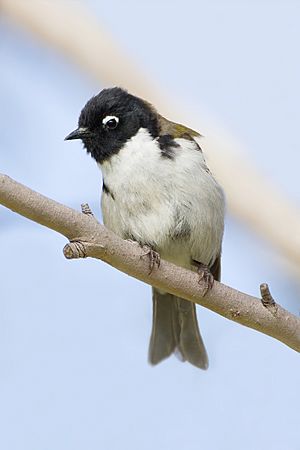Black-headed honeyeater facts for kids
Quick facts for kids Black-headed honeyeater |
|
|---|---|
 |
|
| Conservation status | |
| Scientific classification | |
| Genus: |
Melithreptus
|
| Species: |
affinis
|
The black-headed honeyeater (Melithreptus affinis) is a small bird that belongs to the honeyeater family. It is one of only two types of birds from its group that live only in Tasmania, an island state of Australia.
You can find this bird in temperate forests and areas with shrubby plants that are similar to those found in Mediterranean climates. Even though it's called a "honeyeater," this bird mostly eats insects!
About This Bird
The black-headed honeyeater was first described in 1839. Later, in 1844, another scientist named John Gould also described it, but he probably didn't know it had already been named.
Scientists have studied the DNA of these birds. They found that the black-headed honeyeater is most closely related to the white-naped honeyeater. Their next closest relative is Gilbert's honeyeater. All these birds are part of the Melithreptus group. Many birds in this group are similar in size and have black heads, except for the brown-headed honeyeater.
Honeyeaters are also related to other Australian birds like pardalotes, Australian warblers, and fairywrens.
What Does It Look Like?
The black-headed honeyeater is a medium-sized honeyeater. Its back and wings are olive-green, and its belly is white. It has a completely black head. Unlike some of its relatives, it does not have a white patch on the back of its neck.
Around its eye, there is a patch of bare skin that is blue-white. Its beak is quite small.
Where Does It Live?
This bird lives only in Tasmania. You can also find it on King Island and the Furneaux Group of islands.
It lives in different types of forests, including wet and dry sclerophyll forests. It also likes areas with scrub and heathland. You can even find it in subalpine areas, which are high up in the mountains, reaching altitudes of about 1,200 meters (4,000 feet).
What Does It Eat?
Most of the black-headed honeyeater's diet is made up of insects. It is very good at finding food among the leaves of trees. It doesn't usually look for prey on tree trunks, which is what its relative, the strong-billed honeyeater, does. Because they look for food in different ways, these two bird species rarely compete for the same food.
Sometimes, you might see black-headed honeyeaters hanging upside down from branches while they are looking for food!
See also
 In Spanish: Mielero carinegro para niños
In Spanish: Mielero carinegro para niños


